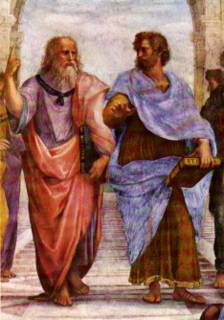The aim of dialogue in the academy is not merely to just state or assert one's opinion. Simply asserting one's opinion to one another has more in common with two dogs barking at each another than two people engaging in dialogue. The aim of dialogue is rather to defend or argue for one’s opinion against any and all objections. The ideal here is the type of dialogues fictionalized in the early writings of Plato. An opinion that cannot be defended against objections has no place in the contemporary academy, just as it had no place in the ancient Greek academy.See: Against Anonymity(bold added for emphasis by me)from discussion at Backreaction: Anonymity in Science
Jeffery did not understand the quality being exposed through the Dialogue to be accurate in his description used by identifying Plato's(what's in a name) Academy to critic against. For the names used were to coordinate perspective exchange to reveal the conclusion Plato wanted set forth?
Clearly, things that are raised in discussion highlight further response and the extensions of ideas as they are presented will become manifest. I was historically touched by the the subject of Being and Names to have this discussion highlighted by my own opinion as it is expressed in terms of what Anonymity means to me and what the subject of the story presents of itself. What then shall we always remember? Awards of distinction according to others by name, or by what we take into ourselves?
One can gain a sense of anonymity not by name but by the quality of truth in the words chosen. These reflect the essence of, and do become recognizable, not by name again, but by that quality of character. Is this quality of character that one sees, destined to come into this world by that some trait to recognizable by a name "only solidifies the world experience," but doe sit really reveal the essence of the person?
What ways can one imagine that such essence is descriptive again to have it mentioned as something that appears distinct from another person, who currently stands beside and reacts to a situation, unique and rightfully different then another does. To reveal, that essence is by quality hidden as essence in this nature of character, was designed by it's entrance into the world.
Plato:CRATYLUS Persons of the dialogue: Socrates - Hermogenes - Cratylus

SOC. But if this is a battle of names, some of them asserting that they are like the truth, others contending that they are, how or by what criterion are we to decide between them? For there are no other names to which appeal can be made, but obviously recourse must be had to another standard which, without employing names, will make clear which of the two are right; and this must be a standard which shows the truth of things.
Crat. I agree.
Soc. But if that is true, Cratylus, then I suppose that things may be known without names?
Crat. Clearly.
Soc. But how would you expect to know them? What other way can there be of knowing them, except the true and natural way, through their affinities, when they are akin to each other, and through themselves? For that which is other and different from them must signify something other and different from them.
Crat. What you are saying is, I think, true.
Soc. Well, but reflect; have we not several times acknowledged that names rightly given are the likenesses and images of the things which they name?
Crat. Yes.
Soc. Let us suppose that to any extent you please you can learn things through the medium of names, and suppose also that you can learn them from the things themselves- which is likely to be the nobler and clearer way to learn of the image, whether the image and the truth of which the image is the expression have been rightly conceived, or to learn of the truth whether the truth and the image of it have been duly executed?
Crat. I should say that we must learn of the truth.
Soc. How real existence is to be studied or discovered is, I suspect, beyond you and me. But we may admit so much, that the knowledge of things is not to be derived from names. No; they must be studied and investigated in themselves.
Crat. Clearly, Socrates.



 PLato saids,"Look to the perfection of the heavens for truth," while Aristotle saids "look around you at what is, if you would know the truth" To Remember: Eskesthai
PLato saids,"Look to the perfection of the heavens for truth," while Aristotle saids "look around you at what is, if you would know the truth" To Remember: Eskesthai



















